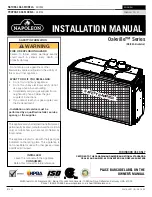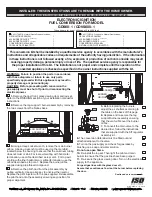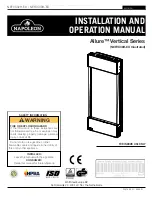
Page 7
Vista 42 ST See-thru Gas Fireplace
rev.110404
Installing the Nailing Flange Extension
Once the fireplace is placed into the framed opening, the supplied nailing exten-
sion must placed along the top edge of the fireplace, and nailed in place to the
framing, as illustrated below. Fasten the steel lintel is in place, see Figure 2. The
supplied nailing extension must be placed along the top edge of the fireplace and
securely fastened in place to the metal lintel and combustible wood framing.
Note:
The nailing flange extension can be substituted with a piece of
NON-
combustible
material of the same size and thermal characteristics, i.e.: cement
board or equivalent.
Installation
Figure 6c.
Installing the Nailing Flange Extension.
Top Vent Venting
Requirements
Before you install any venting, you must determine whether the venting run will
be acceptable. Unacceptable venting can affect the fireplace's combustion.
for installations with horizontal venting runs of 0-16 feet, use the vent graph,
as described below
the maximum horizontal vent run is 16 feet.
The Rear Vent Venting Graph
Measure the vertical height from the fireplace hearth to the center of the termina-
tion and the horizontal run from the from the fireplace flue collar to the wall flange
of the termination. Plot on the Venting Graph (Figure 12) with an 'X'.
If the 'X' falls on or above the top boundary of the shaded area, the installation is
acceptable.
Example A: (Acceptable Installation)
If the vertical dimension from the hearth is 72" and the horizontal run to the
wall flange of the vent termination is 120" the installation is acceptable.
Example B: (Acceptable Installation)
If the vertical dimension from the hearth is 66" and the horizontal run to the
wall flange of the vent termination is 30" the installation is acceptable.
Example C: (Unacceptable Installation)
If the vertical dimension from the floor of the fireplace is 48" and the hori-
zontal run to the wall flange of the vent termination is 84"
the installation
is NOT acceptable.






































